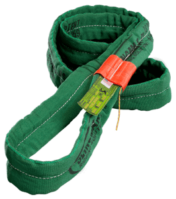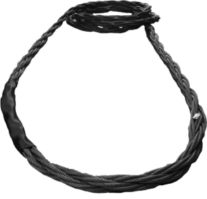Mechanical Considerations
- Load both paths of Twin-Path® slings equally. Do not side load. Do not load the edge of the sling.
- Determine the weight of the load. The weight of the load shall be within the rated capacity of the sling.
- Select a sling having suitable characteristics for the type of load hitch and environment.
- Slings shall not be loaded in excess of the rated capacity. Consideration shall be given to angle of lift which may affect the lifting capacity. Diameters of pins and edges also may affect the capacity of the lifting sling.
- Slings used in a choker shall not be forced to tighten around the load by pounding with hammers or other objects. Choker hitches are the least effective way to use a sling based on capacity. Two chokers should be used to balance the load. One choker in the center of the load may create an unbalanced situation which could lead to an accident.
- Slings used in a basket hitch must have the load balanced to prevent slippage and accidents.
- Slings used with fittings shall be compatible with the fittings used. The lifting capacity shall be rated at the lower of the lifting or sling. Fitting openings shall be the proper shape and size to assure that the sling will seat properly.
- Slings in contact with edges, corners, protrusions, or abrasive surfaces shall be protected with a material of sufficient strength, thickness, and construction to prevent damage. The pin area of a shackle can cause synthetic slings to cut or tear.
- Slings shall not be dragged on the floor or drawn across other surfaces which may damage the sling.
- Slings shall not be twisted or tied in knots to shorten.
- Slings can be damaged by resting loads on them or by pulling slings from under a load.
- Do not drop objects on slings or run over them with vehicles.
- Slings which are damaged shall not be used.
- Sling hitches must provide control of the load.
- Portions of the human body shall be kept from between the sling and the load and from between the sling and any attachment to lifting devices such as hooks.
- Personnel shall stand clear of suspended loads.
- Personnel shall not ride on the sling or suspended loads.
- Avoid shock loading.
- Twisting and kinking the legs of the sling shall be avoided.
- Load applied to the hook should be centered in the bowl of the hooks. Do not point-load the hook.
- During lifting with or without the load all personnel shall be alert for possible snagging.
- The slings shall contain or support the load from the slides above the center of gravity so the load will not tilt when the load is lifted.
- Synthetic roundsling users shall be trained in the selection, inspection, cautions to personnel effects of environment, and rigging practices.
- Only legibly marked or labeled slings must be used. If the tag is not legible, or missing, the sling must not be used.
- Keep labels or tags away from the load the hook and the angle of choke.
- Synthetic slings should be inspected before each lift.
Rigging Handbook
Fill out the form below to download a digital copy of our 2020 Rigging Handbook.

SYNTHETIC SLINGS
Slingmax has been a trusted supplier of high performance synthetic roundslings to the industrial and heavy lifting markets since 1986. Think Twin-Path® slings for all your heavy lifting and rigging needs.

RIGGING ACCESSORIES
The Equalizer Block is used to maintain tension on all legs of the sling during a lift. The Equalizer Block will automatically adjust itself when tension is put on the device from the sling. This was designed specifically for Twin-Path® Extra Slings.

WIRE ROPE DESIGNS
Slingmax multi-part wire rope slings are designed for increased capacity and excellent flexibility. The three-part Tri-Flex, nine-part Gator-Laid, and nine-part Gator-Flex grommet have excellent D/d ratios and can be fabricated in shorter lengths.
Need a Rigging Solution
